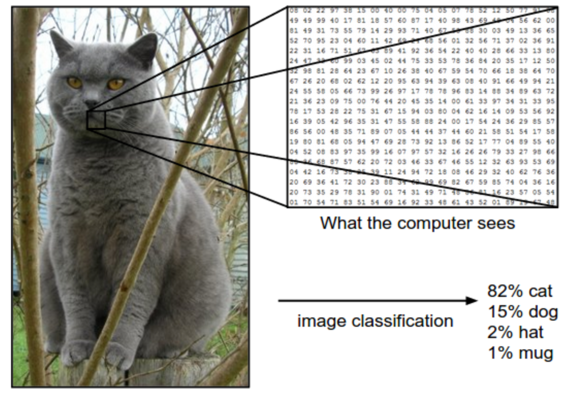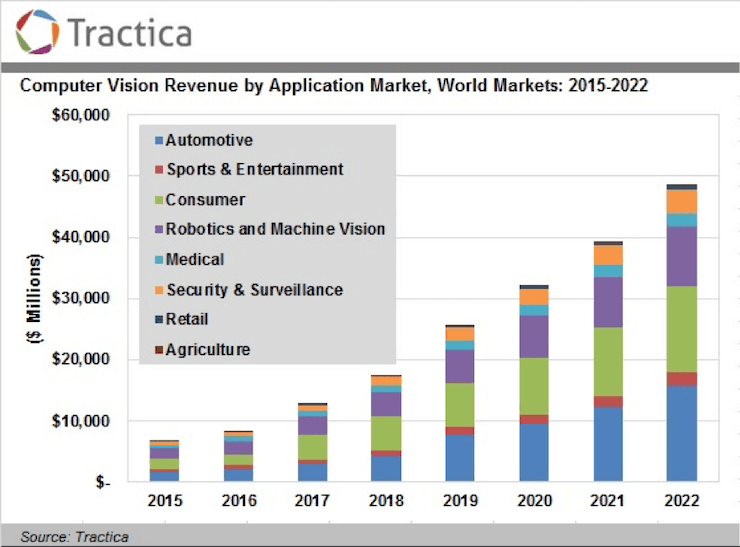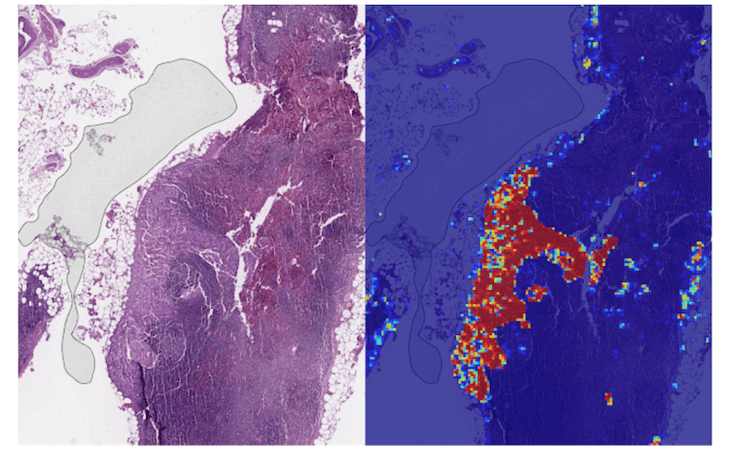The Definition of Computer Vision
How can we define computer vision today? It is a subsection of artificial intelligence that emphasizes developing and refining techniques that let machines capture and understand various digital images and video content.
Today we live in reality awash in visual information. According to HubSpot, 54% of consumers want their favorite brands to deliver more video content. Forbes suggests that websites, exposing a great deal of video content, make average users spend 88% more time on their pages.
To obtain visual information, we have a “superbly efficient tool” – our natural vision. The abilities of machines still lag far behind. By definition, computer vision mimics natural processes: retrieves visual information, handles it, and interprets it. And state-of-the-art algorithms, so-called neural nets used for computer vision tasks, replicate natural neural networks.
What Are the Goals of Computer Vision and How It Works?
Without having machines able to see, it will be difficult to teach machines to think. That is how Fei-Fei Li, from Stanford Vision Lab, describes the role of computer vision technology.
The difficulty is that computers see only digital image representations. Humans can understand the semantic meaning of an image, but machines rarely do. They detect pixels.
Semantic gap is the main challenge in computer vision technology. The human brain – or natural neural networks – distinguishes between components on images and analyzes these components in a certain sequence. Each neuron is responsible for a particular element.
That is why building an artificial solution as superb as the human brain took decades of research and prototyping. And artificial neural networks became the greatest breakthrough in machine learning.
A fundamental task in computer vision has always been image classification. Thanks to the use of deep learning in image recognition and classification, computers can automatically generate and learn features – distinctive characteristics and properties. And based on several features, machines predict what is on the image and show the level of probability.

Source: cs231n.github.io
Powerful deep neural networks enable machines to outdo humans in recognizing and understanding images. Such capabilities are used across industries for face recognition apps, surveillance projects, and ID systems. We have explained the nuances of how visual search systems work in the previous blog post by InData Labs.
There are plenty of other technology-related tasks, and they work well in combinations, like classification – localization or object detection – image segmentation.

Source: cs231n.stanford.edu
This article is going to shed light on the following computer vision solutions:
- Semantic segmentation
- Instance segmentation
- Object detection
- Object tracking
- Action recognition
- Image enhancement
By definition, computer vision solutions can solve a variety of problems, depending on business goals. Let’s find out what computer vision is, and how it can contribute to your business niche.
How Does Computer Vision Methods Work in Different Industries?
Long story short, computer vision technology is one of the most sought-after tech concepts these days. Raconteur reports that the innovation is omnipresent in our lives, from driving cars to using search engines. We are going to dwell upon several popular fields for implementing computer vision solutions:
- AR-enhanced images and videos
- Robots in retail and supply chain
- Advanced medical imaging tools
- Tools to enhance OCR-ed images
- Approaches to mitigate biases in sports
- Techniques to boost agriculture industry
A critical prerequisite to making the innovation a cross-industry trend is data growth worldwide. According to statistics, users share online more than 3 billion images daily. Built-in cameras and personal mobile devices generate data permanently.
What is more, computing power for analysis of massive data has become available and affordable so far.
Deep learning-based models trained on large datasets empower computer vision solutions. These solutions can augment an array of traditional tasks and revamp traditional approaches to solving business challenges. Share on X A variety of industries drives the growth of the CV market, and the number of apps is rather diverse, as seen in the chart below.

The largest growth is yet to come in such domains as automotive, sports & entertainment, robotics, and healthcare.
Medical Image Segmentation
Semantic segmentation and instance segmentation are among the core tasks of the technology. The idea of segmentation is to teach computers to process an image at a pixel level and understand it. In simple words, computers can segment an image, paint objects in the image with different colors, and predict what is on it.
Image segmentation is utilized for medical scan analysis. It allows the highly precise detection of elements that can suggest more about such pathologies as tumors. As Google researchers say, by using computer vision techniques, medical experts reach agreement on the diagnosis in less than 48% of cases. However, AI-based tools assist in detecting cancer metastasis with much higher precision.

Source: Ai.googleblog.com
Timeliness and accuracy in diagnosing different forms of cancer are vital. It has a great impact on how early medical professionals start the correct treatment course. What AI does for saving lives cannot be overstated. And the work on CV-based medical apps is one of the top priorities of many companies worldwide.
Classification & Localization in Predictive Maintenance
One of the tendencies in manufacturing is robotic process automation (RPA). Robots assist in simplifying production workflows, successfully work hand-in-hand with human employees, and efficiently complete a variety of monotonous tasks. And computer vision is a vital part of RPA as it provides machines with human-like eyesight.
AI-led processes of monitoring equipment have become more intelligent and reliable. Now machines can predict breakdowns and help avoid costly downtimes. Likewise, computers can supervise the control of quality on production lines.
The utility industry, sensitive to whatever incidents, can harness advanced real-time monitoring capabilities. It can help better predict risk situations on time and maintain a high level of service.
Computer vision for augmented reality (AR) uncovers more possibilities specific to one or another industry. Assembly and maintenance processes get a boost thanks to the option of using real-time information integrated with real-world objects.

Source: Shutterstock
Manufacturing solutions require various computer vision techniques to solve combinations of such tasks as object detection, localization, image segmentation, and so forth.
Object Detection & Tracking in Sports
Machine learning algorithms in the field of sports have become popular for some reasons. Object detection and object tracking technologies facilitate giving feedback on the quality of actions and help reduce biases in scoring events.
Also, for tracking athletes and their performance, new ways of action quality assessment can be used across different sports. For instance, in figure skating the presentation score is a part of the total score. Thus, the accuracy of action evaluation has a high value. Likewise, assessing gymnastics performance can be dramatically enhanced.
Breakthroughs in computer vision can also assist in the post-game analysis. And for marketing purposes, it can be employed to detect and track the visibility of brand logos in an event broadcast.
How Can We Define 3D Computer Vision?
Deep learning algorithms for computer vision deal with 2D as well as 3D format.
When action recognition became possible, it entailed extra benefits. Now it allows predicting what a player is doing at a given moment: standing, walking, running, or whatever. This capability can ease predicting tense moments in games and thus, give the audience new kinds of experience.

Source: blogs.nvidia.com
Massive datasets should be available to create such kind of solutions. Data to describe each action of an athlete can be gathered through sensors. This data should be translated into the format understood by computers.
After that, a video data model can be built. It stores all actions, labeled properly and assigned to the respective objects, that, in sum, shape the database. The database acts as the source of data for training a convolutional neural network model to process videos.
3D vision allows building 3D point cloud – a representation of an image in the 3D format. This way, computers can catch the location and shape of an object.

Building a point cloud requires measurements of different parts of objects or bodies and dynamic characteristics of these measurements. To get these types of data, engineers use special depth cameras. And this is what 3D computer vision is.
3D vision is successfully employed by Amazon in retail to monitor items without scanning barcodes in the cashier-free stores. In healthcare, it enables real-time patient monitoring during surgery. 3D computer vision technology has also revolutionized manufacturing: it allows robots to see objects, analyze distance, and adjust related processes. This technology has become a must-have to keep head above water in a competitive business environment.
Image Enhancement at Pre-Processing Stage

Source: Slideshare.net
Image processing is a part of automatic text recognition with the use of optical character recognition (OCR) technology. The quality of recognized images or output depends on the quality of input images.
OCR-based image processing software is popular for dealing with various types of documentation. Paper documents, including invoices, tickets, cheques, and other data-rich forms, often require preprocessing before translating into digital format.

Source: Abbyy.technology
This computer vision task helps with the following:
- Adjust brightness, color, and contrast of an original image
- Rotate an image to center an object
- Reduce digital noise caused by poor lighting
Image enhancement is used in the field of security to process and recognize biometric images, improve surveillance systems, or analyze geospatial images to create maps. It enables the more reliable control of product quality. In addition, robots receive a better vision. And the healthcare industry reaps the perks of computer-aided surgery and medical imaging apps.
Object Detection in Supply Chain
Machine learning in the supply chain industry aids in revamping customer experience and automating manual jobs. AI-led solutions help supply chain managers avoid pitfalls and income losses.
RPA allows reduction of costs of warehouses management and helps efficiently prevent bottlenecks in delivering items and replenishing warehouses. Amazon, the largest player in retail, increasingly uses robots for managing warehouses, not to mention advanced computer vision systems that power Amazon’s cashier-free stores. Nonetheless, it triggers debates over the controversial issue of AI taking low-paid jobs while leaving human employees out.
CV-powered solutions augment inventory management. Machine learning can be employed to track items, verify their places, or check goods for missing price labels. Robotic vision can be used to monitor a store and find out-of-stock items. And more, robotic in-store assistants can navigate around the place without bumping into customers or whatever objects.
Image and Video Processing in Agriculture
Amazing examples of AI uses are not limited to machines working indoors. Farming, horse breeding, and even winemaking industries utilize technologies. Among them are visual search, AR-enhanced images or videos to gather and analyze data, or automated monitoring systems to alter many traditional processes.
In Australia, an agricultural organization employs satellite image library for data gathering. They train neural networks to monitor the state of harvest across the country. Such an approach helps improve the quality of harvests and avoid unnecessary financial losses.
Winemaking, being very sensitive to soil conditions, employ AI-led solutions to monitor critical data and predict possible diseases or damage to vineyards. Automated drones supplied with infrared cameras can take images from above. After that, such computer vision techniques as object detection, semantic, and instance segmentation allow making a comprehensive analysis of retrieved images. Technologies help prevent potential productivity losses as well as suggest more favorable land areas for cultivating vines.
To Draw the Line
Computer vision is a booming area in AI. Computational power available today and deep neural networks make it possible to achieve new milestones. Deep learning allows computers to see almost as good as humans.
The tech breakthrough undoubtedly influences the development course of multiple industries. From manufacturing to agriculture, computer vision gains more and more popularity for business-growing and revenue-boosting opportunities it offers.
The challenges of business always determine the choice of software development methodology. While planning your next project, your prime need is to articulate the business goals and necessary functionalities. It is the starting point for each project.
InData Labs has proven track records of successful CV-based solutions for clients from various industries. Our team is at your service to make your project idea come true.
Start Your Next AI Project with InData Labs
Have a project in mind but need some help implementing it? Drop us a line at info@indatalabs.com, we’d love to discuss how we can work with you.


